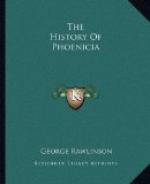Our space will not admit of our pursuing this subject much further. We cannot give descriptions of all the twenty paterae,[777] pronounced by the best critics to be Phoenician, which are contained in the museums of Europe and America. Excellent representations of most of these works of art will be found in Longperier’s “Musee Napoleon III.,” in M. Clermont-Ganneau’s “Imagerie Phenicienne,” and in the “Histoire de l’Art dans l’Antiquite” of MM. Perrot et Chipiez. The bowls brought from Larnaca, from Curium, and from Amathus are especially interesting.[778] We must, however, conclude our survey with a single specimen of the most elaborate kind of patera; and, this being the case, we cannot hesitate to give the preference to the famous “Cup of Praeneste,” which has been carefully figured and described in two of the three works above cited.[779]
The cup in question consists of a thin plate of silver covered over with a layer of gold; its greatest diameter is seven inches and three-fifths. The under or outside is without ornament; the interior is engraved with a number of small objects in low relief. In the centre, and surrounded by a circle of beads, there is a subject to which we shall presently have to return. The zone immediately outside this medallion, which is not quite an inch in width, is filled with a string of eight horses, all of them proceeding at a trot, and following each other to the right. Over each horse two birds fly in the same direction. The horses’ tails are extraordinarily conventional, consisting of a stem with branches, and resembling a conventional palm branch. Outside this zone there is an exterior and a wider one, which is bounded on its outer edge by a huge snake, whose scaly length describes an almost exact circle, excepting towards the tail, where there are some slight sinuosities. This serpent, whose head reaches and a little passes the thin extremity of the tail, is “drawn,” says M. Clermont-Ganneau, “with the hand of a master."[780] It has been compared[781] with the well-known Egyptian and Phoenician symbol for the {kosmos} or universe, which was a serpent with its tail in its mouth. “Naturally,” he continues,[782] “the outer zone by its very position offers the greatest room for development. The artist is here at his ease, and having before him a field




